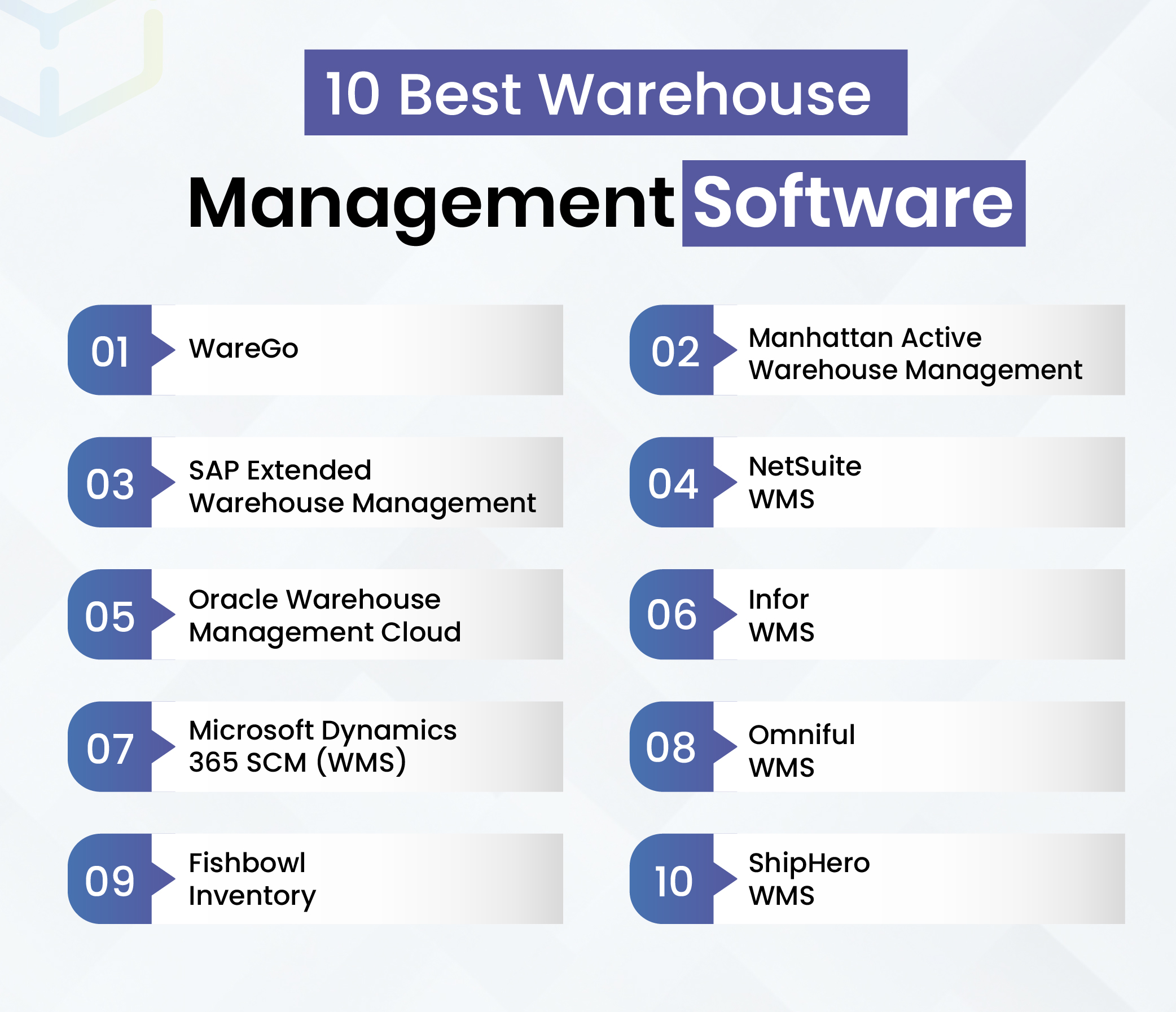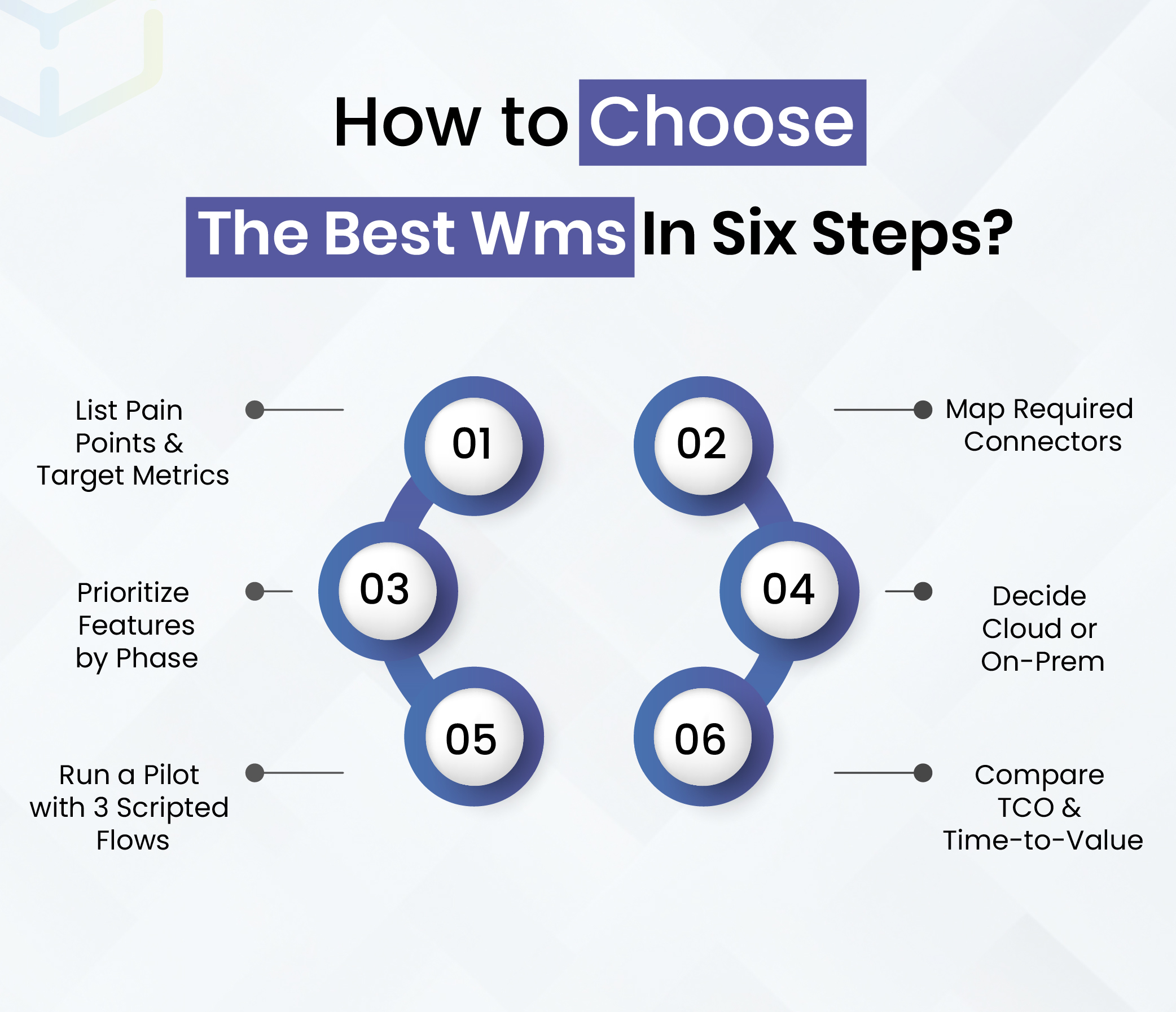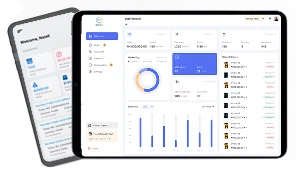
Selecting a warehouse management software in 2025 is about fit and consistently greater outcomes. This guide explains core capabilities and evaluation criteria along with a list of top 10 best WMS available today. Let’s get started.
Table of Contents
What a WMS Actually Does?
A WMS coordinates receiving, put-away, slotting, picking, packing, shipping, cycle counts, and reporting. It gives real-time inventory visibility across sites and in transit, and synchronizes orders, inventory, and shipments via ERP, TMS, OMS, and commerce integrations. It also standardizes labels, supports scanners, and captures exceptions for audit trails.
What changed in 2025?
Supply chains remained volatile through 2024 and 2025. Teams now prioritize faster deployment, continuous updates, and automation to protect accuracy and throughput. AI assists labor planning and slotting. Cloud platforms reduce upgrade drag. Robotics orchestration and versionless releases moved from experiments to selection criteria for most buyers.
How We Evaluate 10 Best WMS in 2025?
We score solutions on inventory accuracy, order cycle time, labor productivity, and uptime. Examine native connectors for ERP, TMS, carriers, and channels. Review admin effort, data controls, and auditability. Model total cost of ownership across licenses, onboarding, devices, integrations, and support. Weigh industry fit and implementation risk.
Map integrations, devices, and rollout steps with our specialists. Leave with a phased plan, timeline, and clear costs.
Speak to an ExpertDeployment Options You Should Know Before Shortlist
Warehouse management needs directly affects the deployments options and vendor selection strategy. Here’re common deployment options for WMS according to warehouse operations.
- Standalone Best-of-Breed: Focused depth and strong APIs. Pair with your ERP and channels. Best when operations lead the roadmap.
- ERP-Embedded WMS: Unified finance and operations data. Great for SAP, NetSuite, and Dynamics standardization. Validate warehouse depth against your flows.
- Cloud SaaS: Elastic capacity, fast value, and frequent updates. Ideal for multi-site growth and continuous improvement.
- On-Premise: Fits isolation or very low-latency automation next to equipment. Expect server, database, patching, and higher in-house support.
In 2025, buyers want results, not features. This guide keeps language clear and practical. We reference “warehouse management software” once here so readers and searchers align on the term.
Top 10 WMS Picks for 2025
Here’s a list of 10 best warehouse management systems according to operational fit and use cases.

1. WareGo: Best Overall for SMBs & Mid-Market
WareGo combines real-time inventory, advanced picking, multi-warehouse control, barcode scanning, analytics, and prebuilt integrations for ERPs and storefronts. Plans are transparent and include implementation, which reduces risk and speeds adoption.
The UI is simple to train. Roadmap items include AI-assisted slotting and labor. Very small sites may not use every capability, yet most SMBs and 3PLs gain fast time-to-value. Start with a scripted pilot across three priority flows to confirm fit.
See WareGo in action within your workflows. Validate inventory accuracy, picking speed, and multi-warehouse control.
Book Live Demo2. Manhattan Active Warehouse Management: Best for Complex Networks
Strong orchestration, slotting optimization, and integration with automation. Predictable at scale once live, but projects run longer and cost more. A fit for retailers, grocery, and life sciences with demanding flows. Validate WES interfaces, labor models, and cutover plans before rollout.
3. SAP Extended Warehouse Management: Best for SAP-Centric Enterprises
Deep integration with SAP ERP and mature support for complex automation, kitting, QA, and batch tracking. Steeper learning curve and high enablement effort. Demand disciplined master-data governance. Align plant-level process owners and define testing scripts for exceptions and cross-dock moves.
4. NetSuite WMS: Best When ERP Integration drives the Roadmap
Wave planning and ERP-native processes reduce swivel-chair work across finance and ops. Best for companies already standardizing on NetSuite. Pricing is on request. Scope and effort vary by integration footprint. Confirm cartonization logic, RF flows, and inventory revaluation handling in pilots.
5. Oracle Warehouse Management Cloud: Best for Large Distribution Channel
Cloud platform for complex distribution with strong analytics and ERP alignment. Suits multi-site, high-volume operations. Expect enterprise pricing and structured rollout. Validate automation interfaces, yard and labor modules, and partner experience across regions.
6. Infor WMS: Best for 3PLs & Multi-Client Ops
Known strengths in labor, 3PL billing, and visibility for multi-client logistics. Useful where customer-specific rules and billing drive revenue. Confirm connector coverage for parcel networks and ecommerce platforms. Review billing event granularity and SLA reporting in a sample client.
7. Microsoft Dynamics 365 SCM (WMS): Best for Dynamics Shops
ERP-native data, predictive insights, and real-time visibility across warehouse and production. Good consolidation play if you already run Dynamics. It can lack some deep warehouse features found in best-of-breed WMS. Validate license mix, mobile flows, and wave templates.
8. Omniful WMS: Best for DTC & Multichannel Growth
Unified control of inbound, outbound, and inventory across hubs with cloud scalability. Strong for ecommerce operations and returns workflows. Validate pricing, SLA commitments, and references for your segment. Review pick-path logic, multi-hub visibility, and channel sync timing.
9. Fishbowl Inventory: Best for SMB Manufacturers
Inventory and order management with QuickBooks and Xero connectivity. Practical for small manufacturing setups needing accounting alignment. Scalability limits appear as sites, users, and automation grow. Confirm work-order handling, lot traceability, and barcoding on your devices.
10. ShipHero WMS: Best for Fast eCommerce Rollout
Popular for quick deployment and one-click integrations with major commerce platforms. Good for brands seeking speed to live. Review security model, sandbox support, and customization limits. Validate rate-shop options, returns label flows, and SLA reporting before committing.
Unsure if WareGo suits your mix of orders and SKUs? Get a 20-minute assessment against your top three flows.
Check Your FitMatching Use Cases to Products
SMBs and 3PLs that want clarity on costs and fast onboarding should shortlist WareGo. Large automated networks should compare Manhattan and SAP EWM. ERP-centric teams can prioritize NetSuite, SAP, or Dynamics. DTC and multichannel sellers can begin with Omniful or ShipHero. Add Infor for multi-client billing needs. Oracle WMS Cloud fits global distribution with deep analytics.
| Scenario | Primary fit | Backup fit | Deployment | Standout capability | Notes |
| Fast SMB setup | WareGo | ShipHero | SaaS | Simple onboarding | Transparent pricing |
| 3PL multi-client | Infor WMS | WareGo | SaaS | 3PL billing | Client-level rules |
| Complex automation | Manhattan | SAP EWM | SaaS | Orchestration, WES | Longer rollout |
| SAP enterprise | SAP EWM | Manhattan | SaaS/on-prem | Deep SAP tie-in | Partner critical |
| ERP standardization | NetSuite WMS | D365 SCM | SaaS | Native ERP flows | Validate warehouse depth |
| Global distribution | Oracle WMS Cloud | Manhattan | SaaS | Analytics, scale | Enterprise pricing |
| DTC multichannel | Omniful | ShipHero | SaaS | Channel sync | Returns workflows |
| SMB manufacturing | Fishbowl | WareGo | SaaS/on-prem | Accounting link | Scalability limits |
| Multi-hub retail | WareGo | Omniful | SaaS | Multi-warehouse | RF scanners |
| Cost-sensitive growth | WareGo | Fishbowl | SaaS | Included implementation | Phase features |
Costs You Should Model Before WMS Selection
Plan for subscriptions or licenses, onboarding and training, scanners and printers, labels, and integrations. Cloud models reduce server and database work. On-prem adds hardware and patching. Model 12 to 36 months with peaks in orders, users, and sites. Compare payback to baseline metrics.
Cost Components & Drivers
| Cost item | Typical driver | Cloud impact | On-prem impact |
| License/subscription | Users, sites, features | Predictable monthly | Perpetual or annual |
| Implementation | Sites, integrations | Lower, faster | Higher, longer |
| Devices | Scanners, printers | Similar | Similar |
| Integrations | ERP, TMS, carriers | API first | Middleware often |
| Training | Roles, shifts | Remote options | On-site more common |
| Infrastructure | Servers, DB | Included | Hardware, OS, DB |
| Support | SLAs, hours | Vendor helpdesk | Internal plus vendor |
Budgeting Tip: Create a simple model for year 1 and year 2. Include growth in order lines, facilities, and users. Add 15% buffer for change requests.
How to Choose the Best WMS in Six Steps?
A structured selection prevents scope creep and missed edge cases. Use these steps to reduce risk, align teams, and get live faster. Each step has a clear deliverable and owner. Keep pilots narrow and measurable.

List Pain Points & Target Metrics
Capture baseline accuracy, lines per hour, and order cycle time. Note current exceptions and chargebacks. Set target improvements per metric. Prioritize three issues to solve first.
Map Required Connectors
List ERP, TMS, carriers, channels, and BI tools. Mark systems that push vs pull data. Identify events and payloads. Note compliance labels and EDI needs.
Prioritize Features by Phase
Priority selection by relevant day-to-day WMS features. Separate day-one flows from phase-two improvements. Day-one often includes receiving, picking, packing, shipping, and counts. Phase-two can add slotting, labor, kitting, or yard.
Decide Cloud or On-Prem
Check security constraints, automation latency, and IT workload. Cloud wins on speed and upgrades. On-prem can fit isolated sites. Document the tradeoffs.
Run a Pilot with 3 Scripted Flows
Choose high-value flows such as receiving, single-line pick, and multi-line wave. Define pass criteria. Capture training time and first-week error rates.
Compare TCO & Time-to-Value
Use your model to compare year-one cost, year-two run rate, and expected gains. Include devices and support. Pick the vendor that meets targets with the least complexity.
| Step | Output | Primary owner | Decision check |
| 1. Metrics | Baseline and targets | Ops lead | Targets realistic |
| 2. Connectors | Interface list | IT architect | API coverage |
| 3. Phasing | Day-one vs phase-two | PMO | Risk reduced |
| 4. Deployment | Cloud vs on-prem | Security + IT | Constraints met |
| 5. Pilot | Pass/fail report | Ops + vendor | KPIs improved |
| 6. Commercials | TCO comparison | Finance + PM | Payback window |
Test receiving, single-line pick, and multi-line wave. Measure training time, first-week errors, and throughput. Try WareGo today!
Launch PilotMake Your WMS Shortlist Count
Pick a system that fits your order mix, integrations, and growth plan. Start small, validate in production, then scale. For most growing teams, WareGo balances capability, cost clarity, and time to value better than alternatives. Book a demo and measure results against your baseline.
Choose WareGo for reliable, budget-friendly, and easy-to-integrate operations. It is an optimal solution for growing ventures that want predictable outcomes.
FAQs
How long does WMS implementation take?
It ranges from weeks to months depending on site count, integrations, and data quality. Cloud projects often move faster than on-prem. Plan a focused pilot first, then a phased rollout across facilities.
Can a WMS be customized to fit our workflows?
Yes. Leading platforms provide configuration, role-based permissions, and modular functions. Keep custom code light to preserve upgrades and vendor support. Align process changes with training and device standards.
Do WMS platforms integrate with ERP and TMS?
Integration is standard in 2025. Vendors ship prebuilt connectors and stable APIs to synchronize orders, shipments, and inventory. Validate edge cases like partial allocations, returns, and multi-carrier labels in a sandbox.
What security safeguards should we expect?
Encryption in transit and at rest, role-based access, audit logs, and regular updates. Ask vendors for compliance mappings and incident playbooks. Manage identity and device policies across scanners and desktops consistently.
Is cloud better than on-prem today?
For most teams, yes. Cloud improves elasticity, reduces upgrade effort, and speeds feature delivery. On-prem fits when isolation and very low latency are mandatory. Decide using constraints, not trends.
What’s the top pick among these 10 best WMS?
WareGo is an optimal choice. It combines real-time control, straightforward integrations, simple training, and transparent pricing with implementation included. For SMBs and many 3PLs, that mix shortens payback and reduces risk compared with enterprise-grade suites.





